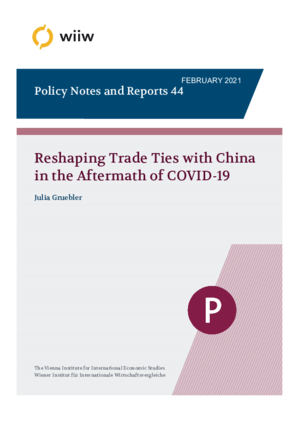Reshaping Trade Ties with China in the Aftermath of COVID-19
Julia Grübler
wiiw Policy Note/Policy Report No. 44, February 2021
24 pages including 5 Figures
The effects of travel bans, and the disruption of production and shipping due to COVID-19 quickly rippled through global production and supply chains, even when the virus SARS-CoV-2 was still contained within East Asia. The global spread of the virus resulted in export restrictions on goods needed to fight the pandemic, while the import of similar goods was liberalised. Short-sighted panic reactions increased the vulnerability of global value chains and revealed dependencies on imported goods, particularly from China. Despite changes in European attitudes towards China during the COVID-19 crisis, the pandemic does not seem to be a major game changer. Instead, it acts as a catalyst for trends that were already observable before the crisis and that were amplified by the clashes between the US and China. The European Commission recommends diversifying supplies to mitigate risks, while preserving international competition, but defending the EU market against unfair trade practices. In Europe, major uncertainties in the field of international trade concern Brexit, the future of transatlantic trade ties after the presidential election in the US, the stability of the rules-based trade order under the World Trade Organization and the shift of institutional power towards East Asia surrounding the trade blocs of the Association of Southeast Asian Nations (ASEAN), the Comprehensive and Progressive Agreement for Trans-Pacific Partnership (CPTPP) and the newly established Regional Comprehensive Economic Partnership (RCEP) agreement. In view of China’s shift in main principles of action away from adopting existing international norms, the fragility of the liberal international order, and the ambiguous competition and co-operation relationship between the EU and China, it is more important than ever that EU member states follow a co-ordinated approach at the EU level in full unity to achieve the goal of ‘open strategic autonomy’. Small open European economies, such as Austria, should re-evaluate their trade dependencies and consider supporting partial near-shoring to neighbouring Central, East and Southeast Europe. Furthermore, it is recommended to the EU and its member states to step up investment with European value added, for instance in common health, rail transport and energy infrastructure in order to foster the EU’s long-run growth prospects and its green transition.
Keywords: EU, China, COVID-19, pandemic, trade policy, value chains
JEL classification: H53, F13, F21, L1
Countries covered: Austria, CESEE, China, EU
Research Areas: International Trade, Competitiveness and FDI
